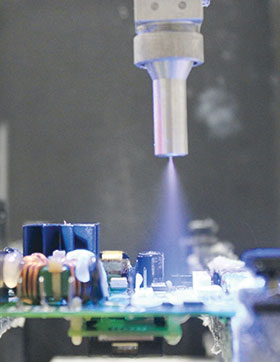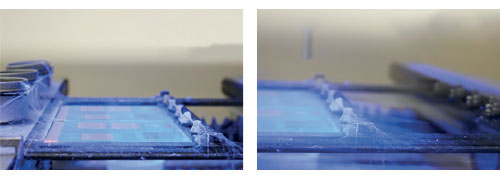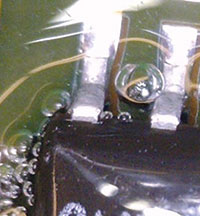

So, you’ve spent a considerable amount of time setting up your conformal coating process only to observe the dreaded cobwebbing effect once you start applying the material. There are some common root causes and simple solutions to get back to applying your coating in a defect-free manner.
What is conformal coating cobwebbing?
Cobwebbing (Figure 1) is the application defect where you see strands or wisps of dried coating floating around the immediate area where the coating is being applied. Users have different names for this: cobwebbing, spider webbing and cotton candy are all terms that are used to describe this application defect.

Why do I get cobwebbing on my applications?
Now, let’s take a deeper look to understand what causes this application defect. The reason is quite simple. Cobwebbing typically occurs only when the coating is being applied by atomised spray. When a coating is being applied via atomised spray, air is being applied to the liquid coating in the application valve (usually at the nozzle) to break it up into smaller droplets. These droplets contain a mixture of solvent and thinners as well as the base conformal coating resin.
Cobwebbing occurs when these small droplets contain too little solvent or thinner, the atomisation pressure is too high or the distance between the application nozzle and the substrate is too high. In effect, the droplets are drying out in mid-air which results in dried coating floating around the application area.
How can I fix this issue?
Ok, so now that we have a basic understanding of what causes cobwebbing, we can take a look at the steps users can take to fix the problem and get back to applying the coating in a defect-free manner. Each of the three typical causes for cobwebbing identified above can be easily addressed.
Mix ratio of solvent/thinner to coating
Simply increase the amount of thinner mixed with the coating. We often use 1:1 or 2:1 (coating to thinner) as a starting point for our mix ratios, however certain coatings and thinners can require the user to adjust (either up or down) this ratio to best suit their unique application process. Variations in application valves, fluid delivery and electronic assembly design layout, as well as the end customer’s final thickness requirements, means that there’s no one size fits all when it comes to setting up your application process and especially the mix ratio of thinner to coating. Increasing the amount of thinner in the coating mixture will prevent the atomised droplets from drying out before they reach the substrate.
Atomisation pressure
When valve atomisation pressure is too high it can effectively ‘boil’ the solvent or thinner in the coating mix due to their low vapour pressure. The thinners and solvents used in most conformal coatings have low vapour pressures by design to reduce the amount of drying and cure time of the applied liquid coating. During the application setup process, users should start with an atomisation pressure set to the lowest possible setting and increase until the coating comes out in an even and consistent width. If you observe cobwebbing, then the atomisation pressure is too high and should be lowered.
Valve height
When the application valve is too high, the thinner/solvent in the atomised droplet will evaporate before reaching the substrate. Due to the wide variation in electronic assembly layouts, it’s not realistic to expect to be able to set the valve at one height and let the program run. For most applications, the user will need to program the valve in such a way where the valve height will change based on the topography of the underlying substrate. When this occurs, the user should fine tune the combination of atomisation pressure and valve height to ensure cobwebbing is avoided.
So, as discussed above, cobwebbing is usually a result of one or more of the above conditions. It’s not without reason to expect that to fully eliminate the application defect you will need to address at least a couple of these root causes. The good thing is that with a little diligence you should be able to quickly adjust each and see results immediately.
Simple techniques to avoid bubbles
For those who have experienced air entrapment in their conformal coating, the following can help you to get rid of those exasperating bubbles in the conformal coating process.
Contrary to what most people think, bubbles are not material-related but are mostly caused by process-related issues. Yes, it is true that the conformal coating contents would have an influence on the number of bubbles. Solvents will definitively generate bubbles if the process is not properly set but one needs to think about several other factors that could negatively affect the result of a coating application in regards to bubbles. What follows are three clever techniques to reduce or eliminate bubbles.
First of all, we need to clearly identify the characteristics of the conformal coating:
Solids content: Conformal coatings would normally include the ‘main resin’, additives and solvents. Solvents will eventually disappear into the atmosphere when curing. The less solids content the coating has, the more solvents it contains, thus more solvents could mean more possibilities of generating bubbles.
Solvent type: Solvent vapour evaporation rate will affect bubble formation. Sometimes the solution lies in the combination of solvents used and oven profiles. Since there are many combinations of these variables, a specialist such as HumiSeal should be contacted to assist with thinner selection.
Curing recommendations: Regularly, the product manufacturer would include some recommendation on how to cure the material. Whether you should cure it at room temperature, heat to accelerate or through a chemical reaction, it is important to know and understand all these recommendations. For example, curing too fast may generate bubbles by trapping solvent vapour under the coating surface.
Viscosity: You might think “why is viscosity relevant for bubbles?” Read on to find out.
When identifying the type of problem, the first distinction is in the size of the bubbles. Small bubbles tend to occur all over the board, and make the coating look like sparkling water; sometimes there are so many small bubbles that they can form a foam. Big bubbles usually appear near large components (see Figure 2). Typically this is a sign of solvent or air escaping from underneath the component but getting trapped before it can escape the coating surface.

The next point to consider is where and when the bubbles are first observed: right after during application with the coating system; after the curing process; or in the conformal coating pot.
One also needs to be aware that the bubbles could be generated from very different parts in the system. First, the pressure pot. Normally the coating system uses a pressurised pot where the coating is pushed through the hoses and connections up to the valve by air pressure. If this pressure is too high, residual air could actually get mixed into the coating. If this happens, the bubbles would rise as soon as this pressure is released. This happens right away after the coating is dispensed through the valve.
It is hard to detect whether the air is mixed with the coating at first sight. If you open the pot, you will see a clean and bubble free liquid. Using a stainless steel spatula or a viscosity cup gently stir the coating. If the coating contains dissolved air, disturbing the liquid will generate small bubbles similar to a sparkling soda. To avoid this:
• Reduce the air pressure used in the tank.
Remember, try to use only the minimum required to have a constant flow through the coating system.
• Make sure that the coating level inside the pot never gets below 35%.
• Don’t leave the pot pressurised when not in use for more than 12 hours. Simply release excess gas from the pressure pot when not in use.
• If you are using a solvent-free conformal coating (UVs and some silicones), you can always ask your supplier if they have bladder bag packaging. You’ll need small changes to your system, but you can forget about bubbles in the pot.
Application of conformal coatings plays an important role in avoidance of bubble formation. In our experience, it is hard to generalise this problem, as a majority of the time this happens with spray and film coating. The reason why it’s really specific for these applications is because they both use additional pressure to work properly. For instance, spraying needs assisted air in the tip of the nozzle to atomise the coating. The higher the pressure you use, the more atomisation you will obtain, but if you go too high on assisted air pressure and dispense too close to the substrate, you can generate a lot of ‘micro-turbulence’ and some bubbles may appear.
Film coating is the same: in order to have a constant fan width you need certain pressure always present in the nozzle. Too close to the substrate and too high in the fluid pressure and you could generate bubbles. To avoid this, just try to improve your coating programs by increasing the distance between the substrate and the tip of the nozzle, or reduce the assisted pressure. This could take some time and programming skills, but the result would be worth the effort.
For more information contact Zetech, +27 (0)11 609 1244, zorlianski@zetech.co.za, www.zetech.co.za
| Tel: | +27 11 609 1244 |
| Email: | zetech@zetech.co.za |
| www: | www.zetech.co.za |
| Articles: | More information and articles about Zetech One |
© Technews Publishing (Pty) Ltd | All Rights Reserved